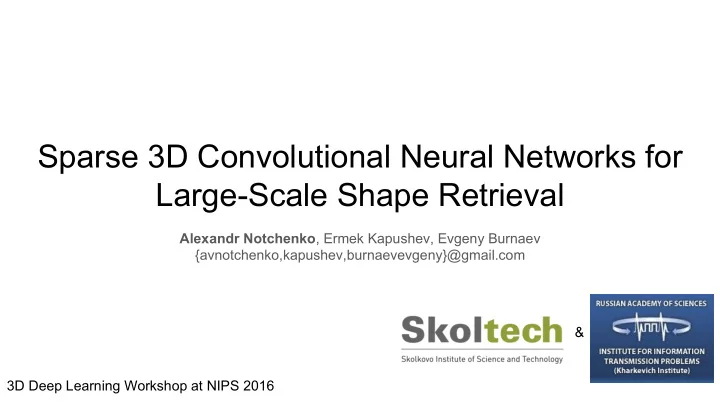

Sparse 3D Convolutional Neural Networks for Large-Scale Shape Retrieval Alexandr Notchenko , Ermek Kapushev, Evgeny Burnaev {avnotchenko,kapushev,burnaevevgeny}@gmail.com & 3D Deep Learning Workshop at NIPS 2016
3D Shape representations ● Meshes ● Point clouds ● Implicit surfaces / potentials ● Voxels ● Set of 2D projections
3D Shape representations ● Meshes Irregular size, not clear how to use in NN ● Point clouds ● Implicit surfaces / potentials ● Voxels Regular size, good to go in CNN ● Set of 2D projections
3D Shape representations ● Meshes Irregular size, not clear how to use in NN ● Point clouds ● Implicit surfaces / potentials ● Voxels Regular size, good to go in CNN ● Set of 2D projections Not really 3D, 2D CNNs are powerful enough already
Sparsity of voxel representation Mean sparsity for all classes of ModelNet40 train dataset at voxel resolution 40 equal to 5.5%.
SparseConvNet Dr. Benjamin Graham formerly: Associate Professor at Warwick University now at Facebook AI Research, Paris Lab http://www2.warwick.ac.uk/fac/sci/statistics/staff/academic-research/graham/bmvc.pdf
PySparseConvNet ● Python wrapper for SparseConvNet, with extended functionality. ● Fixed several Memory issues that prevented large scale learning. ● Made possible to use different loss functions. ● Made layer activations accessible to debugging. ● Interactivity for exploration of models — a way to perform operations step by step, to explore properties of models.
Shape Retrieval Problem statement Given a query object find several the most “similar” to the query objects from the given database. The objects are considered to be similar if they belong to the same category of objects and have similar shapes.
Shape Retrieval Sparse3DCNN V plane - feature vector Precomputed of plane feature vector of dataset. (V car , V person ,...) Query Cosine distance Retrieved items
Triplet loss The representation can be efficiently learned by minimizing triplet loss. Triplet is a set ( a, p, n ), where ● a is an anchor object ● p is a positive object - an object that is similar to anchor object ● n is a negative object - an object that is not similar to anchor object , where is a margin parameter, and are distances between p and a and n and a
Our approach ● Use very large resolutions, and sparse representations. ● Used triplet learning for 3D shapes. ● Used Large Scale Shape Datasets ModelNet.
Network description
Forward Pass Activations
Training Dynamics Can finish learning when all samples outside of margin. Can finish learning when all samples outside of margin. Optimisation algorithm: Constant Learning Rate = 0.002 Nesterov Accelerated Gradient with momentum = 0.99
Obligatory t-SNE
Experimental results method Classification Retrieval AUC Retrieval mAP 3DShapeNet 77.32% 49.94% 49.23% MVCNN 90.10% --- 80.20% 3DSCNN 90.3% 47.30% 45.16% S3DCNN + --- 48.81% 46.71% triplet
State-of-the-art Algorithm ModelNet40 ModelNet40 Classification Retrieval (mAP) Geometry Image [13] 83.9% 51.3% Set-convolution [11] 90% [1] Z. Wu, S. Song, A. Khosla, F. Yu, L. Zhang, X. Tang and J. Xiao. 3D ShapeNets: A Deep Representation for Volumetric Shapes. CVPR2015. 3D-GAN [10] 83.3% [2] D. Maturana and S. Scherer. VoxNet: A 3D Convolutional Neural Network for Real-Time Object Recognition. IROS2015. [3] H. Su, S. Maji, E. Kalogerakis, E. Learned-Miller. Multi-view Convolutional Neural VRN Ensemble [9] 95.54% Networks for 3D Shape Recognition. ICCV2015. [4] B Shi, S Bai, Z Zhou, X Bai. DeepPano: Deep Panoramic Representation for 3-D Shape Recognition. Signal Processing Letters 2015. FusionNet [7] 90.8% [5] Song Bai, Xiang Bai, Zhichao Zhou, Zhaoxiang Zhang, Longin Jan Latecki. GIFT: A Real-time and Scalable 3D Shape Search Engine. CVPR 2016. [6] Edward Johns, Stefan Leutenegger and Andrew J. Davison. Pairwise Decomposition of Pairwise [6] 90.7% Image Sequences for Active Multi-View Recognition CVPR 2016. [7] Vishakh Hegde, Reza Zadeh 3D Object Classification Using Multiple Data Representations. MVCNN [3] 90.1% 79.5% [8] Nima Sedaghat, Mohammadreza Zolfaghari, Thomas Brox Orientation-boosted Voxel Nets for 3D Object Recognition. [9] Andrew Brock, Theodore Lim, J.M. Ritchie, Nick Weston Generative and Discriminative Voxel Modeling with Convolutional Neural Networks. GIFT [5] 83.10% 81.94% [10] Jiajun Wu, Chengkai Zhang, Tianfan Xue, William T. Freeman, Joshua B. Tenenbaum. Learning a Probabilistic Latent Space of Object Shapes via 3D Generative-Adversarial Modeling. NIPS 2016 VoxNet [2] 83% [11] Siamak Ravanbakhsh, Jeff Schneider, Barnabas Poczos. Deep Learning with sets and point clouds [12] A. Garcia-Garcia, F. Gomez-Donoso†, J. Garcia-Rodriguez, S. Orts-Escolano, M. DeepPano [4] 77.63% 76.81% Cazorla, J. Azorin-Lopez PointNet: A 3D Convolutional Neural Network for Real-Time Object Class Recognition [13] Ayan Sinha, Jing Bai, Karthik Ramani Deep Learning 3D Shape Surfaces Using 3DShapeNets [1] 77% 49.2% Geometry Images ECCV 2016
Conclussions ● For Modelnet in voxel form - resolution beyond 30^3 doesn’t improves much ● More voxels - change scale of features, probably needs more layers ● Quality of representation depends on RS non smoothly but is maxed around render size of 55
Thank you. Alexandr Notchenko , Ermek Kapushev, Evgeny Burnaev
Recommend
More recommend